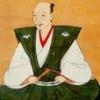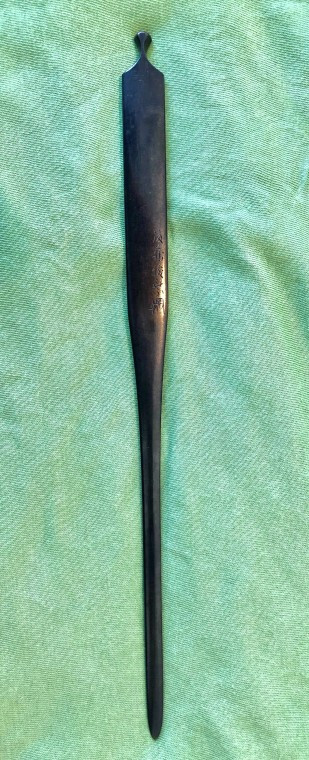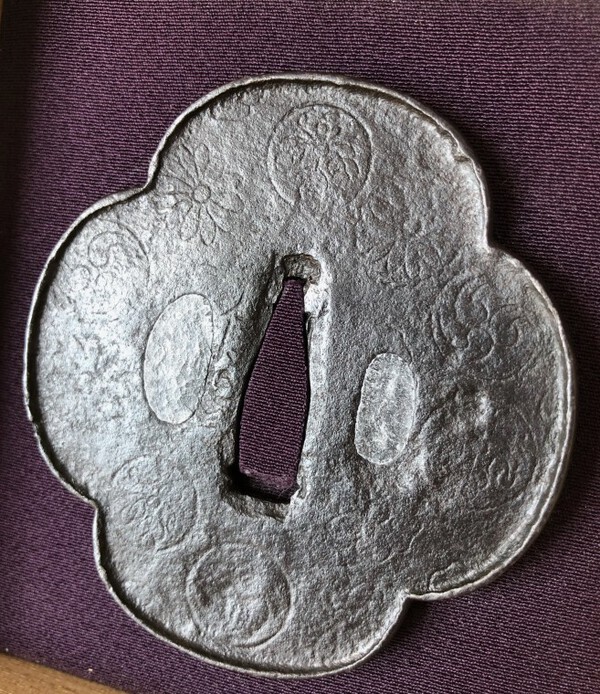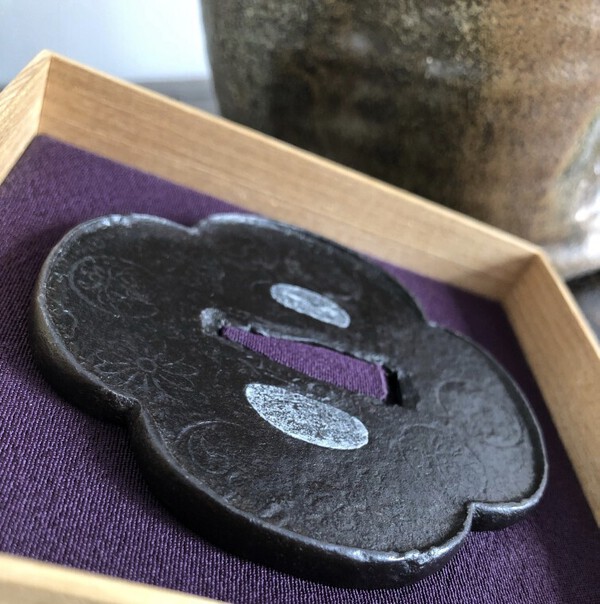-
Posts
959 -
Joined
-
Last visited
-
Days Won
4
Content Type
Profiles
Forums
Events
Store
Downloads
Gallery
Everything posted by Steve Waszak
-

For Sale: High Quality Tsuba Stands - Wood | Acryl design
Steve Waszak replied to Kunehito's topic in Tsuba
Excellent, Tobi! -
What's fascinating about that particular piece is that it's mumei(!), the paper gives it only to "Den Nobuie," and the price is still this high. Of course, being published in the Nobuie Tsuba Shu is going to lift the value to a degree, but this seems like a lot to me. Personally, the one Fred has here -- https://www.nihonto.com/1-1-22/ -- is the strongest of these three.
-
I think Darcy's write-up explains very well the very high values genuine Nobuie tsuba enjoy. It also must be remembered that photos do not do justice to the true appearance of Nobuie (and many other) tsuba. In real life, true Shodai and Nidai works are stunning, featuring a depth of color and taking on a patina I have not seen matched by any other maker's work. I have some personal experience with the tsuba in Darcy's write-up: it is astonishingly beautiful in hand, but not so much in Darcy's photos. Knowing firsthand the difference between how Nobuie swordguards come across in photos compared to what they actually look like when being held, I imagine the tsuba in the Aoi listing is vastly superior to how it may come across in the photos.
-

Darcy Brockbank
Steve Waszak replied to Ted Tenold's topic in Sword Shows, Events, Community News and Legislation Issues
Really in too much shock to comment properly... Unfathomable loss. Deepest condolences to his family and friends. -
Ah, thanks, Glen, for the explanation. I appreciate it. Yes, I can see why you had these statements in your post, then. I guess I would just say that, while Nidai work can be as good as that of the two Shodai smiths, I wouldn't quite say it is on another (higher) level. His workmanship can be more complex, it is true (e.g. he will sometimes have, in combination, uchikaeshi mimi, extremely expressive tsuchime, brilliant tekkotsu, and the finest amida-yasuri of any tsubako in history, IMHO), but conversely, it doesn't quite attain the hugely expressive sculptural power of the work of O-Shodai, and it lacks the nuanced finesse often achieved by the Meijin-Shodai. None of these qualities would make one "better" than the other, objectively speaking, but subjectively, certainly, we might prefer the tsuba of one of these smiths to those of the other. In my view, all three are absolute masters. Interesting note: the Nidai has five Juyo pieces to his name, while the O-Shodai (Yamasaka Kichibei) has "only" four. However, it must be considered that there are far fewer O-Shodai pieces extant, so a much higher percentage of his known works are Juyo than is the case with the Nidai. This, incidentally, must be factored in when we are reviewing how many Juyo works exist for a given smith or "school": how many pieces made by a particular tsubako are there, and of these, what percentage attain Juyo levels? In some cases, there may be hundreds of pieces extant belonging to a certain maker or school, but "only" perhaps ten are Juyo; on the other hand, there may be only a few dozen works known by another master, but of these, ten are Juyo. This may suggest a higher "ranking" for the latter... I'll look forward to reading your further posts in this and other threads, Glen. Steve
-
Hi Glen, Good thoughts posted here. I was struck, however, by this statement: "Second generation Yamakichibei is more highly prized than the 1st gen founder for that entire style. The 2nd gen smith really took the designs and execution to a higher level." When you say that second-generation Yamakichibei is more highly prized than the first-generation founder, I'm wondering where this notion comes from. Do you have a source for this statement? And as far as the second-generation smith "really [taking] the designs and execution to a higher level," I'd also like to know the source for this sentiment. In my experience, neither of these is quite correct... Steve
-

“Swords of the Tea Masters” Article
Steve Waszak replied to Mark S.'s topic in General Nihonto Related Discussion
Many thanks for this, Mark. A very interesting and informative read. In particular, I appreciate how much it underscores the high importance of Tea Culture for the buke in the Momoyama and early-Edo periods. -
Wish I had one for everyone!
-
PM sent.
-
-
-
-
Goto Shunjo (1740-1822) was the grandfather of the great Goto Ichijo. The lineage here begins with Goto Kenjo (1586-1663), the seventh mainline Shirobei master. This kogai is excellent in both its execution and condition, featuring fine, even nanako as a background for the long-earred rabbit motif. The eyes of the rabbit are inlaid in gold. There is very little wear evident. The overall presentation of this kogai is very pleasing, with the smooth contours of the form of the rabbit juxtaposed against the crisp, clear nanako work. The kogai is signed on the reverse, Goto Shunjo. Measurements are 21.1cm x 1.2cm. Circa late-18th century. Boxed. A very fine shakudo kogai. $850.00, plus shipping. CORRECTION! A fellow member with much more knowledge than I on the Goto lineage of fittings makers has corrected me with regards to the identity of the Goto smith who made this kogai. It seems there were two Goto Shunjo smiths, one who was also known as Mitsunaga (1634-1712). This is the actual maker of this kogai. He dates to roughly a century earlier than the later Goto Shunjo (Mitsukazu) who was Goto Ichijo's grandfather. So, the proper dating of this kogai is actually likely to be the latter part of the 17th century. Below please find an image of the chart detailing the lineage. Sorry for the error! And many thanks to the member who PM'd me with the correction! Steve
-

Translation assistance, please :)
Steve Waszak replied to Steve Waszak's topic in Translation Assistance
Thanks so much, Matt. Much appreciated! -
Would anyone be able to read/translate this signature for me? Many thanks in advance... Cheers, Steve
-

Darcy's current tosogu listings
Steve Waszak replied to Brian's topic in Auctions and Online Sales or Sellers
-

Darcy's current tosogu listings
Steve Waszak replied to Brian's topic in Auctions and Online Sales or Sellers
Darcy's offerings are truly top-shelf. Thanks, Brian, for starting this thread. You're right, we do need to expose ourselves to high(est)-level items, whether in blades or tosogu, lest we begin to see the merely good as great, and the "merely" great as magnificent. In fittings, Darcy does favor the soft-metal side of things; however, he occasionally throws a bone to some of the early iron works. Fortunately for me. https://yuhindo.com/nobuie/ -
Sanmai on that, Curran? Ah, yes, well that right there certainly changes things. Thanks for the good insight and education. Cheers, Steve
-
Hi Bob, Yes, that's a nice one on Fred's site. In my somewhat limited experience with Ohno, that's about as large as I see them (and this one is larger than most). Shoami does seem to be the "grab bag" of tsuba attribution all right... That vertical stanchion would appear to be deliberately askew, which in my view adds much interest and more liveliness to the guard, not just for its resulting expression, but also in raising questions of the maker's intent. A good, solid tsuba, Bob. Well done.
-
Hi Bob, Nice guard. Due to its size alone I would tend to doubt Ohno. I rarely see Ohno work larger than 7.5cm, and in fact, 7cm is more in keeping with what I usually see in tsuba attributed to Ohno. This piece reminds me of the very first tsuba I ever bought, roughly a million years ago now (in tsuba collecting years), pictured below (photos taken from Jinsoo Kim's site), and attributed to Shoami. There are differences, of course, in sugata and hitsuana shape, and the shape of the seppa-dai is markedly different, but it wouldn't surprise me if they were from the same "school." The size of this one is 8.8cm x 5mm. I think guards of this size are rather rare in the Edo Period, so I would place both of these in the pre-Edo years (16th century). My best guess, anyway. Cheers, Steve
-
Hi Mikolaj, This tsuba ,in my view, is probably a later "homage" piece. The mei is certainly not that of any of the Momoyama Yamakichibei men, and it does not strike me as likely to have been done by either of the Norisuke smiths: not only is the stroke production quite different from the way the Norisuke inscribe the "Yamakichibei" characters when they make homage pieces, but also, the Norisuke smiths would usually (or always) also sign their Yamakichibei utsushi with their own names, too, often in so doing indicating the utsushi intent behind the making of the work (thanks to Curran for pointing this out to me 🙂). Further, the workmanship (metal treatment) does not align very tightly with the Norisuke Yamakichi guards I have seen. At the same time, the edges of the sukashi appear too crisp/sharp for genuine early Yamakichibei work. What's interesting about this guard, and one of the indicators that it is probably a later copy/homage work, is that there appears to be an effort to emulate the mei of the Shodai (not Yamasaka Kichibei or "O-Shodai, but the "Meijin Shodai"), yet the actual design and features are decidedly Nidai. The Shodai Yamakichibei did not use uchikaeshi-mimi or sukinokoshi-mimi, so the fact that we see that feature on a tsuba with a Meijin-Shodai-esque signature creates a contradiction. At the same time, there are other curious details. The width of the nakago-ana is rather noteworthy -- it seems quite wide, and, given the size of the tsuba overall, would seem to have been intended to accommodate a pretty substantial blade. The sekigane hint at the the possibility of the tsuba having been mounted at least twice. Both of these details may point to earlier production, but of course, we cannot reach any definite conclusions based on this. It looks to be a pretty well done utsushi, Mikolaj. Here is the tsuba I have that is very similar to it -- a Nidai Yamakichibei piece. Cheers, Steve
-
Not that I know of, no. I certainly haven't heard of any. I'm not sure that such pattern books existed for tsubako in the Momoyama and earliest-Edo years. I'd be interested to hear of any, though.
-
David, Not sure about Robert Buroway's comment at the time he made it, but presently, that comment certainly would not be accurate. As to the tsuba you posted, I'm not sure that it would qualify even as revivalist. Nothing about it suggest even a rudimentary understanding of Yamakichibei workmanship or sensibilities (the amida yasuri is far from how the Yamakichibei smiths [notably, the Nidai] did it). Take the inscription away, and who would look at this piece and say, "Yamakichibei"? This strikes me as perhaps a post-Edo, or even post-Meiji item. I can't even really call it a copy, since it has no Yamakichi features at all. Even the motif is not one they used...





















